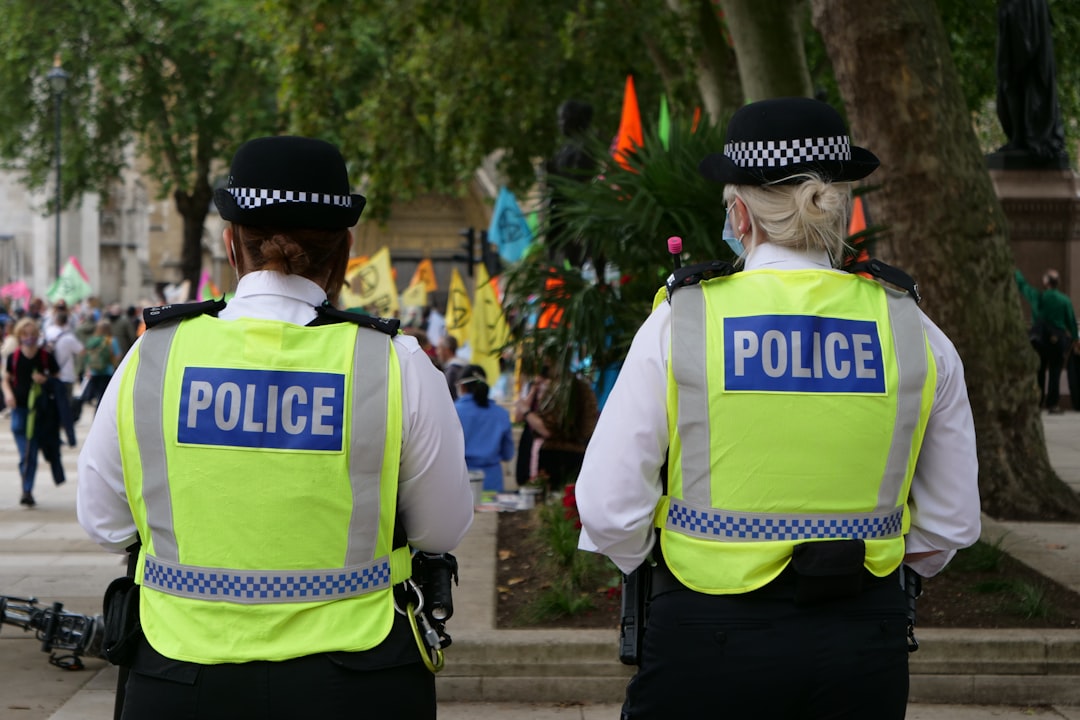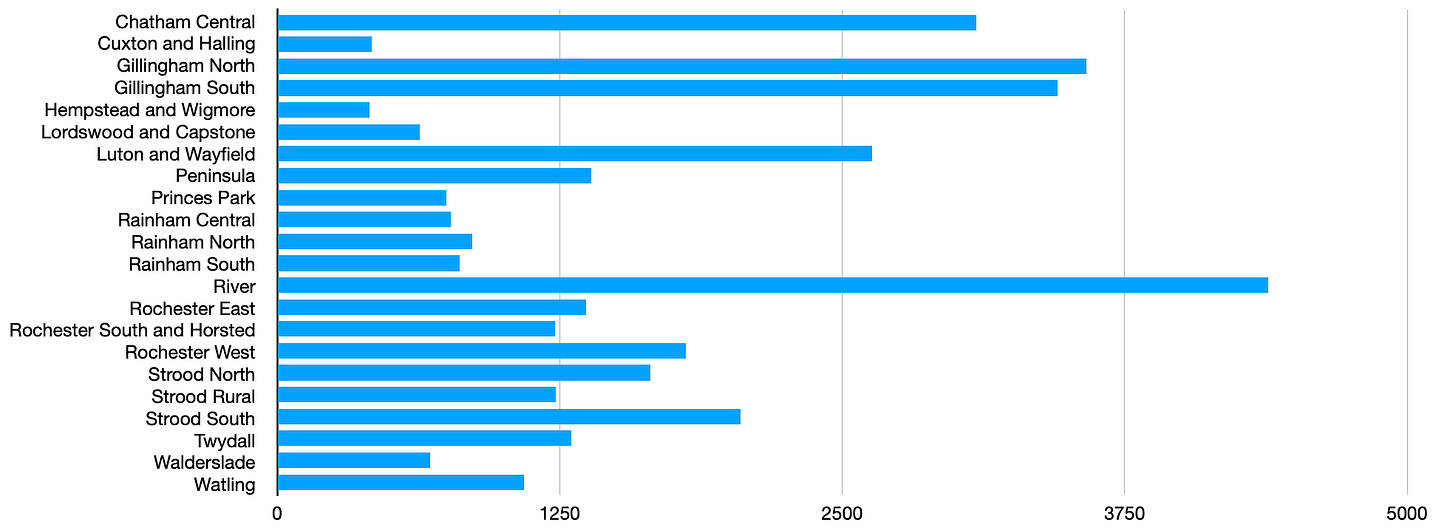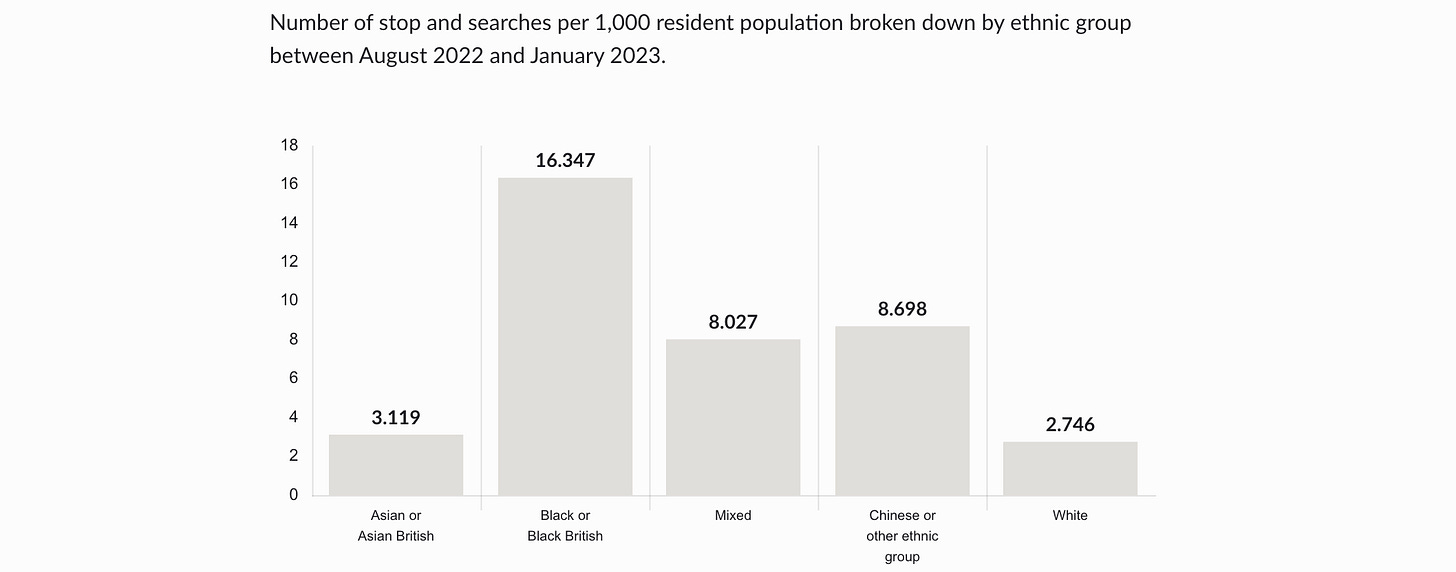Barely any crimes are solved in Medway
A whole bunch of police data that doesn't paint a cheerful picture
A special data driven edition of Local Authority today, as I trawl through the crime data for Medway and try to figure out if our streets are the lawless warzones some seem to portray them as…
Crime is back in the news again. There’s apparently a public perception that crime is out of control, and Labour have launched a significant policy around it.
We all know that perception and reality aren’t always the same though.
So just what is the crime situation in Medway?
As with many things, it’s complicated.
Some caveats before we begin: The majority of data included in this piece is collated from police.uk, who host national crime data broken down by local area. To simplify the data collection, most data is for February 2022 to January 2023. However, stop and search data is for the period January 2022 to December 2022.
The headline figure
It’s surprisingly difficult to come up with overall Medway figures on crime, but pulling together the local data from across our 22 wards provides an overall figure of 35,566 recorded crimes during the 12 months to January 2023.
It is worth noting here that the recorded crime is very unlikely to be the same as the overall crime figure. A lot of crimes go unreported for a number of reasons, from criminal victims not reporting perpetrators to victims feeling reporting as being pointless to undetected crime. But for the sake of this piece, we’ll use the 35,566 figure.
To quote the excellent BBC podcast More or Less, the important question will always be ‘is it a big number?’
It certainly sounds like one. Medway had a recorded population of 279,800 in 2021, which indicates roughly one crime for every 8 residents in the last 12 months.
Comparison
So it’s fair to say that there is quite a lot of crime in Medway. But is it particularly out of the ordinary?
When Medway is compared against similar areas economically and socially across the UK, we’re at the higher end of the spectrum. Our rates are notably higher than similar areas like Havant, Gosport, or Corby, but at the very least we can be thankful that we aren’t Bolton.
In perhaps the least surprising chart in this article, when compared against other parts of Kent, Medway is one of the highest crime areas within the county. While Sevenoaks, Tunbridge Wells, and Tonbridge & Mallong are bastions of law and order, Medway gets to sit between Dartford & Gravesham and Thanet at the top of the table.
The crimes
This is where we take a turn for the depressing.
A lot of different crimes are recorded in Medway, as they are in most areas, but it’s quite jarring just how many of the most serious crimes dominate here.
Of the 35,566 crimes in Medway, 15,201 of them (42.7% of the total) were violent or sexual offences. I’m not sure what I can say about that figure, and I certainly don’t have a snarky comment about it. It’s horrible and something we should all be mortified by.
After that, and it’s a long way behind, is anti-social behaviour (4,964), followed by criminal damage and arson (3,439), the helpfully named ‘other theft’ (2,449), with public order (2,336) rounding out the top five.
Shoplifting (1,799) is fairly prevalent across our towns, as is vehicle crime (1,761), the even more unhelpfully named ‘other crime’ (1,067), with burglaries (952) and drugs (678) popping up less than I would have expected. Bicycle thefts (209) are surprisingly low too, though I suspect that’s more down to people not bothering to report such things more than anything else.
Location, location, location
Unsurprisingly, crime rates vary significant across Medway, sometimes to a startling degree.
River is far and away the ward with the highest crime rate, recording 4,385 crimes over the past year (12.3% of all crime in Medway). This might sound surprising for an area that contains fancy new builds like St. Mary’s Island and Rochester Riverside, but it does also feature Chatham High Street and the Intra area between Sun Pier and Star Hill to balance things out.
Next up are Gillingham North (3,581), Gillingham South (3,452), Chatham Central (3,093), and Luton and Wayfield (2,632). At the other end of the spectrum, but the crime free utopias of Medway are Hempstead and Wigmore (406), Cuxton and Halling (417), Lordswood and Capstone (631), Walderslade (675), and Princes Park (749).
Stop and search
Stop and search is a controversial police tactic that allows police officers to stop and search individuals if they have ‘reasonable grounds’ to suspect you may be carrying something illegal or stolen or something that might facilitate committing a crime.
It’s a grim tactic and Kent Police’s own data proves that they disproportionately use these powers against all non-white groups, but specifically against black individuals.
At this point it is worth noting how overwhelmingly white Kent Police officers tend to be (96.1%), significantly above the average of the Kent population, which is already incredibly white (93.5%) in itself.
Stop and search is also use disproportionately across the Medway towns, with 22.5% of all searches occurring in River ward despite 12.3% of crimes taking place there. You are nearly 200 times more likely to be stopped and searched by the police in River ward compared to Lordswood and Capstone, despite the crime rate being 6 times higher.
Consequences
For some reason, it’s relatively difficult to find out exactly how many recorded crimes end up with a conviction.
We do know that it isn’t very many though.
From Kent Police’s figures, over 40% of investigations in Medway conclude with them being unable to prosecute a suspect, another 29% end with no suspect being identified, the they conclude there’s no public interest investigating 2.4% of cases. So that’s over 70% of crimes that never see any further action.
2.3% of crimes from last year are currently awaiting a court outcome, which suggests at least that many make it to a prosecution. Another 1.5% are listed as ‘court result unavailable’, 0.5% end in a caution, and 0.4% reach local resolution. That’s still less than 5% of crimes that are recorded as having reached any form of meaningful conclusion.
To be fair, 14.1% of crimes are recorded as ‘other’ and 2.6% are listed as ‘status update unavailable’, which is unhelpful, and could include convictions, but quite why the data isn’t clear on this is rather beyond me.
Still, it is clear regardless that the vast majority of crimes recorded in Medway never see any prosecuted as a result, which can’t be helping a public perception that crime is commonplace. If you are unfortunately a victim of a crime, and nothing happens, it’s going to be hard to have confidence that crime is being effectively tackled.
There isn’t necessarily an easy answer to this. Some will argue that more resources need to be thrown into policing, but as we have seen in recent days, police institutions can be instutitonally racist, misogynist, and homophobic. There are alternative ways to do things beyond reinforcing these problematic institutions, like putting the extra resources spent on policing into things that actually reduce crime instead like mental health services, affordable housing, and youth programmes.
I won’t be holding my breath for that to happen though.
Footnotes
Over two-thirds of the general admission tickets have been booked for our debate ahead of the local elections. It’ll take place on April 19 at MidKent College in Gillingham. Don’t forget to book your free ticket and submit a question for our potential future leaders.
Music that soundtracked the creation of this newsletter: Broken by Fulhäst, and Sucker Supreme by Rosie Tucker,










Whenever crime is mentioned, it seems the major parties automatically shout for more police but they never shout for more barristers and courts. Yet your data shows many crimes are waiting resolution. If the courts were well funded and quick, maybe more people would have faith in the justice system as a whole.
Putting aside the other issues around stop-and-search for a moment, the data presented sort of explains high numbers in River, as logically that would be where the police are spending most of their time/resources. Plus a fairly linear route to/from the HQ via areas containing the shopping/night time economy.